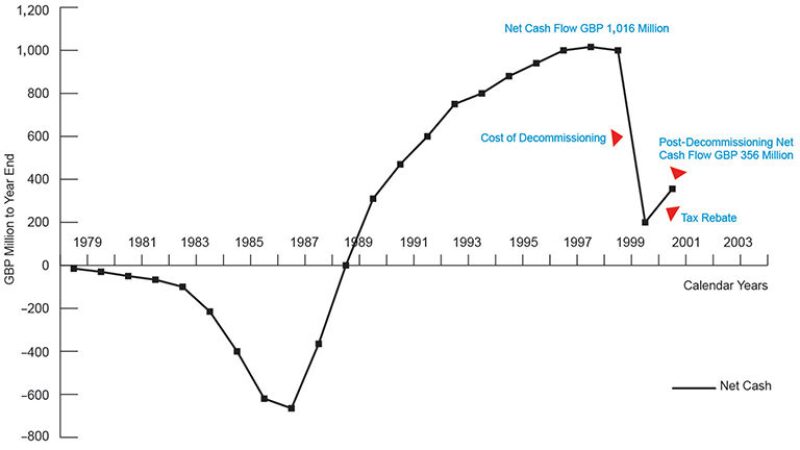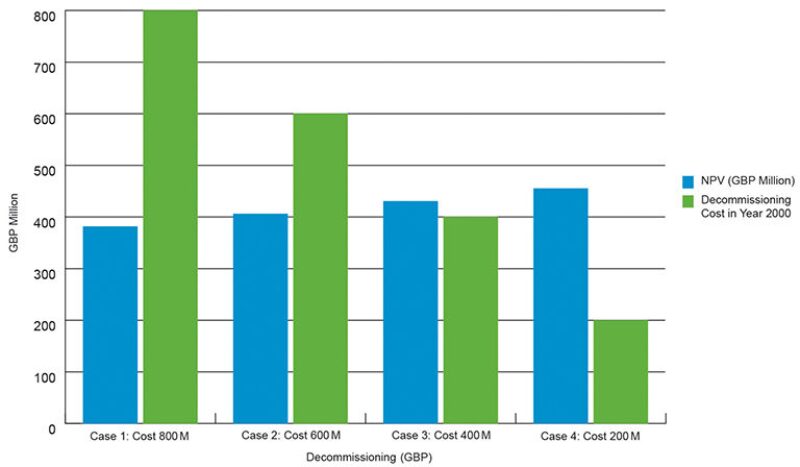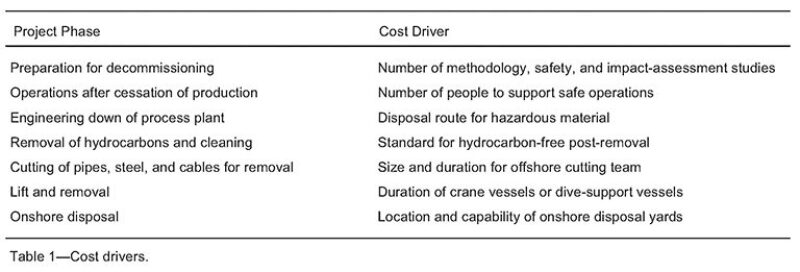Many offshore decommissioning costs are higher than necessary because of decisions made during the initial engineering and construction for an oil or gas field. Economics for a 60,000-BOPD oil field show that a reduction in decommissioning costs of 50% can increase the project net present value (NPV) by 13%. A 5-year range of decommissioning data collected from throughout the world has been studied. Key areas have been identified in which decisions made during design affected the eventual decommissioning costs.
Introduction
Decommissioning/removal of an offshore platform in 100 m of water is a complex project. Decommissioning of a platform in a severe environment can cost hundreds of millions of GBP. New-development project teams need to spend as much effort preparing for decommissioning in the design stage as they do preparing for the maintenance of the platform.
Costs can be reduced during the actual decommissioning work by application of a contracting strategy and the use of previous experience and new technology. However, many costs are fixed because of the design features of the fixed platform or compliant structure. This paper provides guidance on how to engineer for decommissioning during the design stage of a new project.
Project Economics
The cost of decommissioning has to be included in the cash flow of the development because the late-life production rate is included. A typical North Sea platform in 80 m of water for a throughput of 65,000 BOPD with a 15-year field life has a cash flow that starts negative, turns positive, and then ends negative with decommissioning (Fig. 1). The final decommissioning cost before tax refund was estimated to be GBP 800 million.

If the decommissioning cost can be reduced, the NPV of the project will be increased. Results of four NPV calculations as the decommissioning cost was reduced from GBP 800 million to 200 million are shown in Fig. 2. In halving the decommissioning cost from GBP 800 million to 400 million, the NPV of the project increases by 13%. These calculations assume a major short-term cash expenditure with the facilities being decommissioned using cash-intensive methodologies over 1 year. Other operators might want to design their new facilities to be decommissioned over a 4-year period at reduced cash flow, with consideration given to the knock-on effects of keeping utilities and the accommodation operable for the 4-year period.

Significantly, the extended decommissioning project has an increase on the NPV of 30% because of the discount rate being applied to the decommissioning costs over 4 years rather than 1 year. When this 30% is added to the 15% increase resulting from cost reduction, the project NPV improves dramatically.
Value Drivers for a Decommissioning Project
The following are the decommissioning priorities of the operator:
- Safety: Complete the project with no harm to people or the environment.
- Cost: Cost-effective execution minimizes costs.
- Reputation: Operators have a responsibility to all stakeholders.
- Future liability: Post-project responsibility is to be minimized.
- Man-hours: Minimize operator man-hours on the project.
The first two of these value drivers will be affected by decisions made in design.
North Sea Decommissioning Costs
The main costs are grouped in the five stages of a decommissioning project:
- Operator project-management and facility-operation costs
- Well plug and abandonment
- Facility and pipeline
- Topside, substructure, and seabed equipment—removal and site remediation
- Topside and substructure recycling
Cost Drivers
The major cost drivers for the removal of the facilities are provided in Table 1. The cost drivers for the plug and abandonment of the wells are not included because they are not within the scope of this paper. For each stage of the project, one major cost driver has been identified. This list is not exhaustive, but it demonstrates the techniques in reducing decommission costs during the design stage.

Cost Reduction
Standardization provides cost savings in the new project and also in decommissioning. A standard design results in savings in removal time. There will be greater familiarity with tasks because they will have been completed on a previous platform. If a series of identical platforms are removed, a cost reduction of 10% platform after platform could be achieved. This prediction is based on work performed in the shipbuilding industry in the UK and Sweden and on offshore oil projects. This 10% reduction could be built into the decommissioning-cost estimate at the conceptual design stage. During the “Define” phase of the project (see Fig. 3), the following actions will reduce decommissioning costs:
- A section of the accommodation module with a few beds should be self-contained, with its own utilities, for a decommissioning team.
- The wellhead deck should be designed to be capable of taking the loads from a coiled-tubing rig.
- The emergency power generator should be capable of generating a 1.5-MW load for 24 hr/D.
- The design life for the facilities and structure should be cessation of production plus 5 years.
- The flotel bridge landing should have connections to the platform firefighting water main pipes, the compressed-air main pipes, and the fire-detection system.

Detail-Design Stage
In this stage, the following points should be addressed:
Fixed Platforms.
- Access to the structure from the sea because the helideck may be decommissioned.
- Rapid hazardous-waste removal and disposal.
- Tertiary-steel-work connections: The connections for light fittings, handrails, and pipe supports fail as the platform ages. Some failures could be eliminated because they are caused by water in a corrosion trap or by a fatigue crack from the weld of the connection to the secondary steel. The tertiary steel should receive the same design scrutiny as the secondary steel.
- Module lift pad eyes should be retained for use during removal; recessed pad eyes do not provide any obstruction for subsequent platform operations.
- Escape and evacuation routes: Galvanized gratings have a limited life. It is suggested that fiber-reinforced-plastic gratings be used wherever possible.
- Pipework should be designed with no dead legs, and traps would facilitate the flushing and cleaning operation to remove all the hydrocarbons and hazardous wastes.
Compliant Structures.
- Tension-leg-platform, semisubmersible, and spar seawater-ballasting systems transfer a small amount of ballast water during operation to maintain stability. Decommissioning needs a large amount of ballast water. Will the ballast system be available for a large quantity of ballast-water transfer, or does the design for installation have large pumps that can be replaced for the decommissioning?
- The disconnection equipment on a floating production, storage, and offtake (FPSO) vessel needs to be designed for regular inspection and maintenance so the system will disconnect the FPSO for removal.
- The long-term integrity of crude-oil-tank washing machines on an FPSO.
Seabed Facilities.
- The long-term structural integrity of end connections of umbilicals and flexible hoses, because they will be lifted by the ends during decommissioning.
- Use of a geotextile membrane below the mud mats to assist in mat removal.
- The design for pigging and flushing of all export pipelines, seabed flowlines, and umbilicals.
- The flow and return for bulk removal of hydrocarbons in seabed flowlines and methanol lines.
- Use of bigger and stronger pad eyes on the template to allow for extra weight uncertainty during removal.
Decommissioning in Design
All oil and gas companies in the offshore industry have a structured approach to projects (Fig. 3). The structure allows for careful evaluation of all choices and review before major capital expenditure is committed to a development. The first three stages are the key to a successful project because the work is scoped carefully and decisions are evaluated by all stakeholders.
In the Identify phase of a project, decommissioning need not be considered. The installation cost for each proposal will be considered, and a method will be proposed for installation. This method can be used to remove the development at the end of field life because if the platform can be installed in one way, it can be removed the same way. Thus, at this stage, the project cost has an allowance for decommissioning only as part of the project economics. The author suggests that 25% of total new-build cost be assigned as a negative cash flow at the end of field life to each option to provide an allowance for decommissioning.
In the Evaluate phase, three options usually will be taken forward for further engineering. During this work, sufficient engineering will have been completed for the methodology study, schedule, and cost estimate to be completed for each option. As Evaluate comes to the end, decommissioning should be part of the selection process. A methodology study and a schedule will give certainty to the cost estimates and improve the decision. The duration of these studies should be approximately 50 hours for each option.
Reduction of costs is needed in the Define stage. This reduction is achieved by confirming that cost savings and design criteria have been included in the engineering. During Define, the methodology for removal should be developed to the same level of detail as found in the installation, hookup, and commissioning methods. This decommissioning-study work should take approximately 200 hours from a multidisciplinary team and then a further 100 hours to add clauses to the basis of design.
In detailed design, the commissioning procedure and draining-down procedure for shutdown should be reviewed for their applicability during decommissioning. The normal project reviews should ascertain that the basis of design for decommissioning has been followed. The final design should be developed with a methodology of removal and cost and schedule because the cost estimate will be used for the decommissioning liability in the company balance sheet.
Maintenance
Removal of all compliant structures will depend on certain items operating that were used for installation and not afterward. The decommissioning team should review the maintenance schedule in preparation for the time when they will need to implement the removal (for example, release gears for risers and mooring chains). The schedule must be reviewed to ascertain that those function tests are completed so that the release equipment will function. The flushing and cleaning equipment also should be function-tested.
The safety-critical elements will be functioning after production has ceased for a variable length of time. The specification and performance criteria for all safety-critical elements (e.g., cranes, lighting, escape and evacuation routes, fire detection and suppression, and utilities) should include a 5-year duration after production has ceased.
Stage-Gate Review
Stage-gate reviews should include decommissioning. The review should examine the methodology and schedule with as much effort as the team will put into the review of the operations and maintenance proposals. The critical stage-gate reviews are from the Evaluate through the Define stage, and from the Define through the Execute stage. The engineering-design review, on completion of the detailed design in the Execute stage, should follow up the actions raised at all stage-gate reviews. Some typical issues to be raised at the two stage-gate reviews are discussed in Table 2 of the complete paper.
This article, written by JPT Technology Editor Chris Carpenter, contains highlights of paper OTC 25247, “Decommissioning Costs Can Be Reduced,” by Alan William Stokes, SPE, WorleyParsons, prepared for the 2014 Offshore Technology Conference, Houston, 5–8 May. The paper has not been peer reviewed. Copyright 2014 Offshore Technology Conference. Reproduced by permission.

